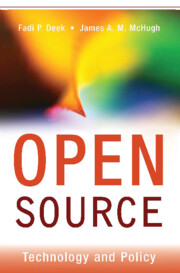Book contents
- Frontmatter
- Contents
- Preface
- Acknowledgments
- 1 Introduction
- Section One Open Source – Internet Applications, Platforms, and Technologies
- Section Two Social, Psychological, Legal, and Economic Aspects of Open Source
- 5 Demographics, Sociology, and Psychology of Open Source Development
- 6 Legal Issues in Open Source
- 7 The Economics of Open Source
- Section Three Free Software: The Movement, The Public Sector, and the Future
- Glossary
- Subject Index
- Author Index
- References
6 - Legal Issues in Open Source
Published online by Cambridge University Press: 16 January 2010
- Frontmatter
- Contents
- Preface
- Acknowledgments
- 1 Introduction
- Section One Open Source – Internet Applications, Platforms, and Technologies
- Section Two Social, Psychological, Legal, and Economic Aspects of Open Source
- 5 Demographics, Sociology, and Psychology of Open Source Development
- 6 Legal Issues in Open Source
- 7 The Economics of Open Source
- Section Three Free Software: The Movement, The Public Sector, and the Future
- Glossary
- Subject Index
- Author Index
- References
Summary
Much of the impetus for the free and open software movement arose as a reaction to legal issues related to software licensing. Consequently, questions concerning what is commonly called intellectual property have been a habitual feature of the open source landscape. Intellectual property includes creations like copyrighted works, patented inventions, and proprietary software. The purpose of this chapter is to survey some of the relevant legal issues in this domain in an accessible manner informative for understanding their relevance to free and open development. The legal and business mechanisms that have been developed to protect intellectual property are intended to address the core objective of protecting creations in order to provide appropriate incentives for innovators. Traditionally, such protection has been accomplished through exclusion. For example, under copyright law, one is not allowed to distribute a copyrighted work without the authorization of the owner of the copyright. The General Public License (GPL) that lies at the heart of the free software movement takes an unconventional perspective on the use of copyright. It focuses not on how to exclude others from using your work, but on how to preserve the free and open distribution of your work when you do allow others to modify and redistribute it (Weber, 2004). We will consider the basic legal concepts associated with intellectual property and how they have been brought to bear in the open source movement.
- Type
- Chapter
- Information
- Open SourceTechnology and Policy, pp. 222 - 264Publisher: Cambridge University PressPrint publication year: 2007



